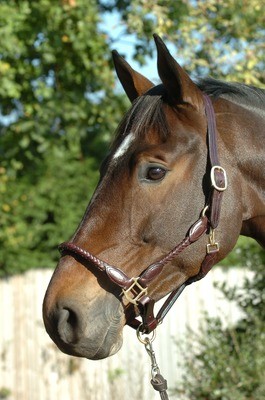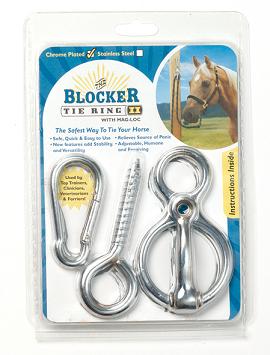
blockers tie ring II - stainless
Looking round your yard how many pieces of baling twine to you see used as break-away when horses are tied up? What most people forget is that 21 century baling twine is nylon, super strong and resistant to breakage; that’s why it is used in agriculture to hold giant tonne plus size hay bales together. In that emergency situation when you need bale twine to give, there is a strong likelihood that nylon baling twine will not give away.
There are alternatives out there now which are made of elastic, but as anyone who has ever felt the sting of elastic will know, the recoil under sudden sharp force can really hurt, which is the last thing you want to happen to your horse in an emergency situation. Plastic breakaways offer a better option but if you have a horse that is learning to tie or that you are re-training you don't want to be continually replacing ties every time they get chewed by baby or snapped. This is the situation we found ourselves in when retraining some of our foundlings and while starting to train blue. That was until a Blocker Tie-Ring II appeared inside Blue's Christmas stocking.
The Blocker Tie-Ring II is a unique way to tie a horse securely yet safely. Its stainless steel construction means it will last years even in our soggy British climate. The clear Mag-Loc feature holds the tongue in place, making the tie ring stable so it can be mounted at any height using the snap clip provided. This also makes it portable meaning you can unclip your tie ring and take it with you to use while travelling in your horsebox, outside the trailer at the show or even use it for highlines when camping with your horse (plus you can use them for you hammock to!)
Why we like it:
- No more injuries to neck vertebrae by releasing pressue when your pulls back;
- No more broken halters or snapped lead ropes;
- Solves the age old question of 'to tie or not to tie' when travelling your horse;
- No open parts to catch on halters, etc;
- The tie ring is designed to work at any angle or height;
- Additional levels of security available when needed;
- Carabina snap means you can move positions easily;
- Has multiple uses, single fixing, trailer tie, highline, cross-ties;
- Ideal for re-training horses who pull back on lead ropes.
- Stainless Steel so it will last for years!
We only sell products we use, because of this we've found we like using stall plate fixings with Blocker Tie Ring IIs so we include one stall plate fixing for FREE in your package when you purchase your Blocker Tie Ring II - Stainless.
The blocker is best used with an extra long lead rope (ideally 3m) but you can easily regulate the degree of hold by altering the length and thickness of the leadrope.
Remember never leave your horse unsupervised when teaching it to tie.


